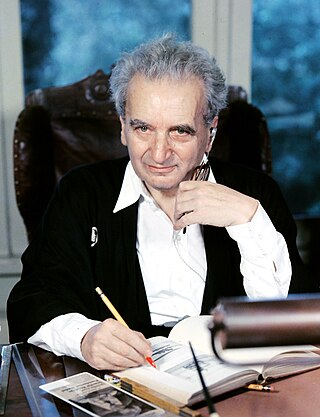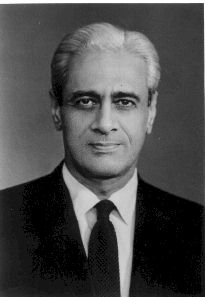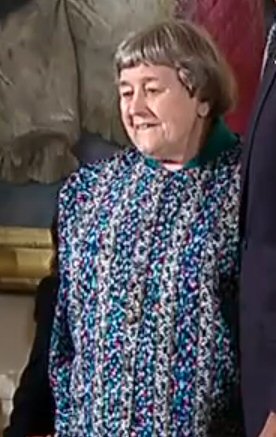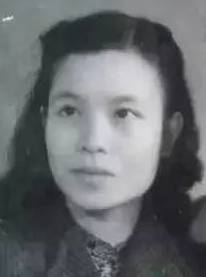Related Research Articles

Aeronautics is the science or art involved with the study, design, and manufacturing of air flight-capable machines, and the techniques of operating aircraft and rockets within the atmosphere. The British Royal Aeronautical Society identifies the aspects of "aeronautical Art, Science and Engineering" and "The profession of Aeronautics ."

Theodore von Kármán, was a Hungarian-American mathematician, aerospace engineer, and physicist who worked in aeronautics and astronautics. He was responsible for crucial advances in aerodynamics characterizing supersonic and hypersonic airflow. The human-defined threshold of outer space is named the "Kármán line" in recognition of his work. Kármán is regarded as an outstanding aerodynamic theoretician of the 20th century.

Qian Xuesen was a Chinese aerospace engineer and cyberneticist who made significant contributions to the field of aerodynamics and established engineering cybernetics. He achieved recognition as one of America's leading experts in rockets and high-speed flight theory.

The American Institute of Aeronautics and Astronautics (AIAA) is a professional society for the field of aerospace engineering. The AIAA is the U.S. representative on the International Astronautical Federation and the International Council of the Aeronautical Sciences. In 2015, it had more than 30,000 members among aerospace professionals worldwide.

Norman Ralph "Norm" Augustine is a U.S. aerospace businessman who served as United States Under Secretary of the Army from 1975 to 1977. Augustine served as chairman and CEO of the Lockheed Martin Corporation. He was chairman of the Review of United States Human Space Flight Plans Committee.

Robert T. Jones,, was an American aerodynamicist and aeronautical engineer for NACA and later NASA. He was known at NASA as "one of the premier aeronautical engineers of the twentieth century".

The Nanjing University of Aeronautics and Astronautics is a public university in Nanjing, Jiangsu, China. It is affiliated with the Ministry of Industry and Information Technology. The university is part of Project 211 and the Double First-Class Construction.

Satish Dhawan was an Indian mathematician and aerospace engineer, widely regarded as the father of experimental fluid dynamics research in India. Born in Srinagar, Dhawan was educated in India and further on in United States. Dhawan was one of the most eminent researchers in the field of turbulence and boundary layers, leading the successful and indigenous development of the Indian space programme. He succeeded M. G. K. Menon, as the third chairman of the Indian Space Research Organisation (ISRO) in 1972. The second launch pad of ISRO, Satish Dhawan space centre is named after him. He is greatly regarded as the man behind A. P. J. Abdul Kalam.
Robert Duncan Luce was an American mathematician and social scientist, and one of the most preeminent figures in the field of mathematical psychology. At the end of his life, he held the position of Distinguished Research Professor of Cognitive Science at the University of California, Irvine.

Roddam Narasimha FRS was an Indian aerospace scientist and fluid dynamicist. He was a professor of Aerospace Engineering at the Indian Institute of Science (1962–1999), director of the National Aerospace Laboratories (1984–1993) and the chairman of the Engineering Mechanics Unit at Jawaharlal Nehru Centre for Advanced Scientific Research. He was the DST Year-of-Science Chair Professor at JNCASR and concurrently held the Pratt & Whitney Chair in Science and Engineering at the University of Hyderabad. Narasimha was awarded the Padma Vibhushan, India's second-highest civilian award, in 2013. for his contributions to advance India's aerospace technology.
Cambridge Scientific Abstracts was a division of Cambridge Information Group and provider of online databases, based in Bethesda, Maryland, before merging with ProQuest of Ann Arbor, Michigan, in 2007. CSA hosted databases of abstracts and developed taxonomic indexing of scholarly articles. These databases were hosted on the CSA Illumina platform and were available alongside add-on products like CSA Illustrata. The company produced numerous bibliographic databases in different fields of the arts and humanities, natural and social sciences, and technology. Thus, coverage included materials science, environmental sciences and pollution management, biological sciences, aquatic sciences and fisheries, biotechnology, engineering, computer science, sociology, linguistics, and other areas.

The Guggenheim Aeronautical Laboratory at the California Institute of Technology (GALCIT), was a research institute created in 1926, at first specializing in aeronautics research. In 1930, Hungarian scientist Theodore von Kármán accepted the directorship of the lab and emigrated to the United States. Under his leadership, work on rockets began there in 1936. GALCIT was the first—and from 1936 to 1940 the only—university-based rocket research center. Based on GALCIT's JATO project at the time, the Jet Propulsion Laboratory was established under a contract with the United States Army in November 1943.
Ali Hasan Nayfeh was a Palestinian-Jordanian mathematician, mechanical engineer and physicist. He is regarded as the most influential scholar and scientist in the area of applied nonlinear dynamics in mechanics and engineering. He was the inaugural winner of the Thomas K. Caughey Dynamics Award, and was awarded the Benjamin Franklin Medal in mechanical engineering. His pioneering work in nonlinear dynamics has been influential in the construction and maintenance of machines and structures that are common in daily life, such as ships, cranes, bridges, buildings, skyscrapers, jet engines, rocket engines, aircraft and spacecraft.
Satya Atluri was an Indian American engineer, educator, researcher and scientist in aerospace engineering, mechanical engineering and computational sciences, who was a Distinguished Professor Emeritus of Aerospace Engineering at the University of California, Irvine. Since 1966, he made fundamental contributions to the development of finite element methods, boundary element methods, Meshless Local Petrov-Galerkin (MLPG) methods, Fragile Points Methods (FPM), Local Variational Iteration Methods, for general problems of engineering, solid mechanics, fluid dynamics, heat transfer, flexoelectricity, ferromagnetics, gradient and nonlocal theories, nonlinear dynamics, shell theories, micromechanics of materials, structural integrity and damage tolerance, Orbital mechanics, Astrodynamics, digital Twins of Aerospace Systems, etc.
The Proceedings of the IEEE is a monthly peer-reviewed scientific journal published by the Institute of Electrical and Electronics Engineers (IEEE). The journal focuses on electrical engineering and computer science. According to the Journal Citation Reports, the journal has a 2017 impact factor of 9.107, ranking it sixth in the category "Engineering, Electrical & Electronic." In 2018, it became fifth with an enhanced impact factor of 10.694.

Hyman Norman Abramson was an American engineer and scientist. He was the Executive Vice President of the Southwest Research Institute at the University of Texas at Austin, and the manager and principal investigator in several NAE and NRC research projects.

The AIAA Journal is a peer-reviewed scientific journal published monthly by the American Institute of Aeronautics and Astronautics. It covers all areas of aeronautics and astronautics, particularly with respect to new theoretical and experimental developments. The current editor-in-chief is Tom I-P. Shih from Purdue University. According to the Journal Citation Reports, its 2020 impact factor is 2.127, ranking it 8th out of 34 journals in the category "Engineering, Aerospace".

Gregorio Ynciong Zara was a Filipino engineer, physicist, a National Scientist, and inventor. He was known as the father of videoconferencing for having invented the first two-way videophone. He was also one of the country's pioneer aeronautical engineer having invented an airplane engine that ran on plain alcohol as fuel. Among his other notable inventions include a solar-powered water heater,, the discovery of the physical law of electrical kinetic resistance called the Zara effect,, and a propeller-cutting machine, among others.

Yvonne Madelaine Brill was a Canadian American rocket and jet propulsion engineer. She is responsible for inventing the Electrothermal Hydrazine Thruster (EHT/Resistojet), a fuel-efficient rocket thruster that keeps today’s satellites in orbit, and holds a patent for its invention. During her career she was involved in a broad range of national space programs in the United States, including NASA and the International Maritime Satellite Organization.

Li Minhua, also known as Minghua Lee Wu, was a Chinese aerospace engineer and physicist who was an expert in solid mechanics. The first woman to earn a PhD in mechanical engineering from the Massachusetts Institute of Technology, she was one of the founding scientists at the Institute of Mechanics of the Chinese Academy of Sciences (CAS), and was elected as an academician in 1980. Her husband Wu Zhonghua was also an accomplished physicist and CAS academician.
References
- ↑ "The iAS – early years (1932-1945)". American Institute of Aeronautics and Astronautics. Archived from the original on 2013-12-02. Retrieved 2008-12-03.
- ↑ The IAS - Later Years (1945 to 1963) Archived 2013-12-02 at the Wayback Machine . AIAA. 2012.